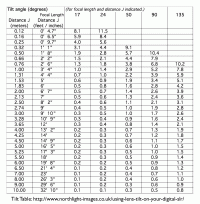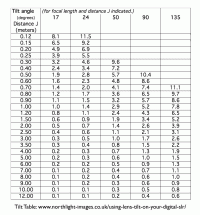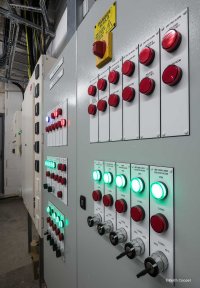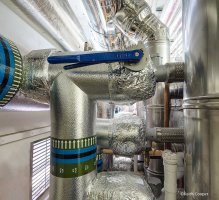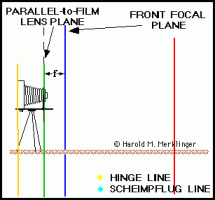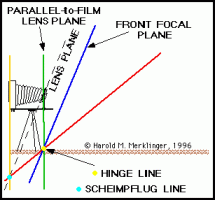I keep this laminated in my bag
View attachment 197500
It's the lenses I currently can use with tilt. The 35/55/80/210 are Mamiya645 lenses I use with an adapter
It's from a spreadsheet that can be customised to whatever focal lengths you have available. It has the distinct advantage of not needing charging and not needing my reading glasses to use. You can also spot easy to remember values.
So, for example with the TS-E17... If I want the plane of focus (focus ring set at infinity for all values above) to pass 50 cm from the lens I need just 2 degrees of tilt.
The plane passes the camera below (ground?) for downwards tilt or any other plane if the lens is rotated
Here's the version with just current Canon lenses from when I was testing the new ones
View attachment 197501
BTW there is a feet and inches version available ;-)
So, for this example (17), with the lens tilted to the right, the distance from the centre of the camera optical axis was perhaps 40cm (just over a foot) from the plane of the panel.
View attachment 197502
You estimate the distance parallel to the back of the camera, to where it intersects the subject plane.
The tilt table says 2.4 degrees. Now you cant set the lenses that precisely (another question for the RF tilt/shift?) so I take it as a bit over 2 degrees
However, with the camera pointing the way it does, the desired plane cuts across diagonally in front.
Simply changing the focus setting swings the focal plane to run along the panel. Using f/10 reduces vignetting and makes any use of tilt less obvious.
Why the shot? It's for an architectural and design company who had just refurbished a hospital. Most of the job was gleaming new corridors, rooms and machines that go ping, but the various plant rooms needed assorted pics.
This is just one that goes with some flat-on shots - most of which just needed shift. I do ones like this knowing that bits will be chopped out for web/article use - this is where supplying big images also helps give whoever gets the pics of this job (~120) to work with some flexibility.
Oh, and yes, there was a thought that I might have something to use in an article explaining some aspect of tilt/shift ;-)
If I'm honest, I much prefer looking around newly installed plant, than spotless corridors ;-)
View attachment 197503



